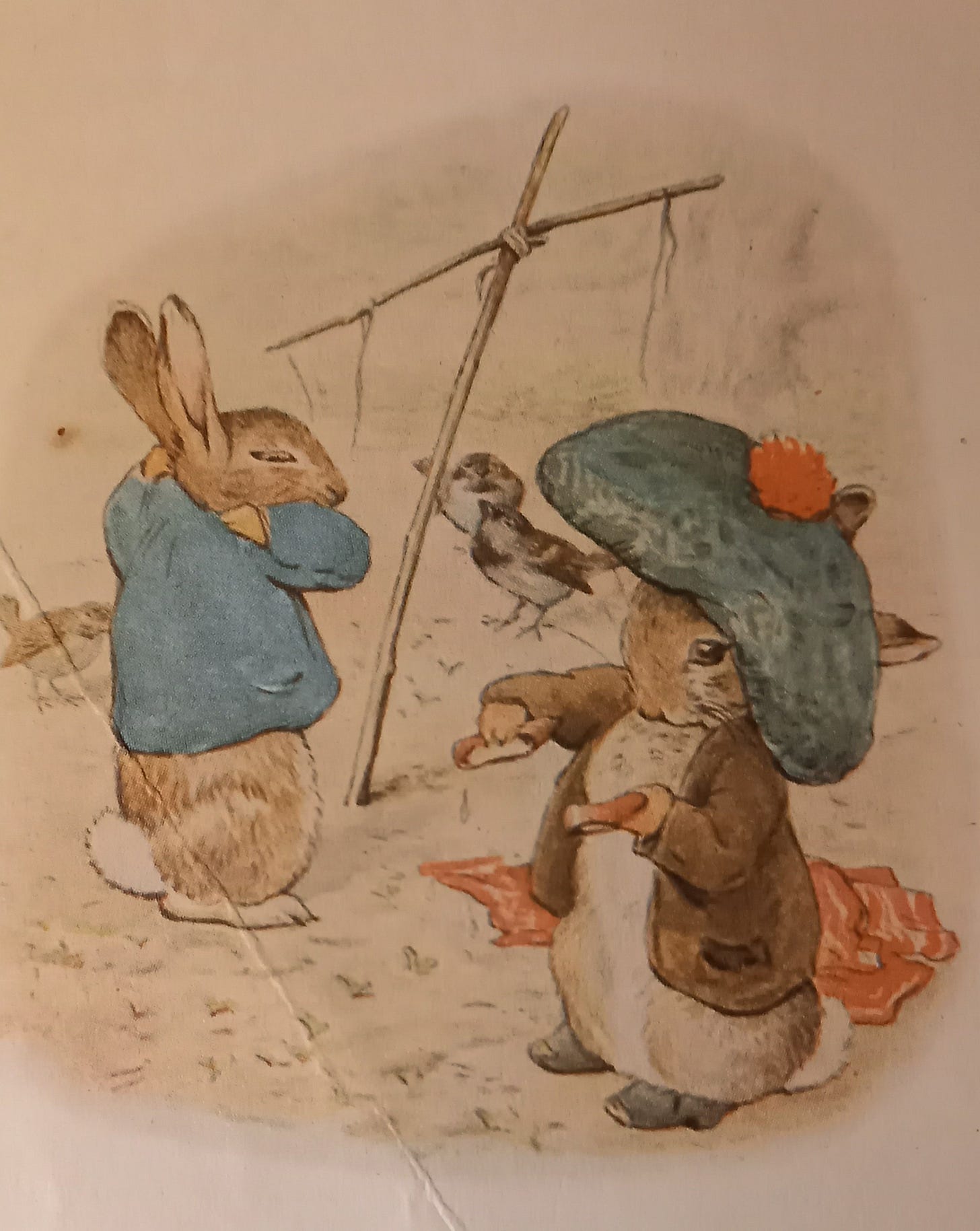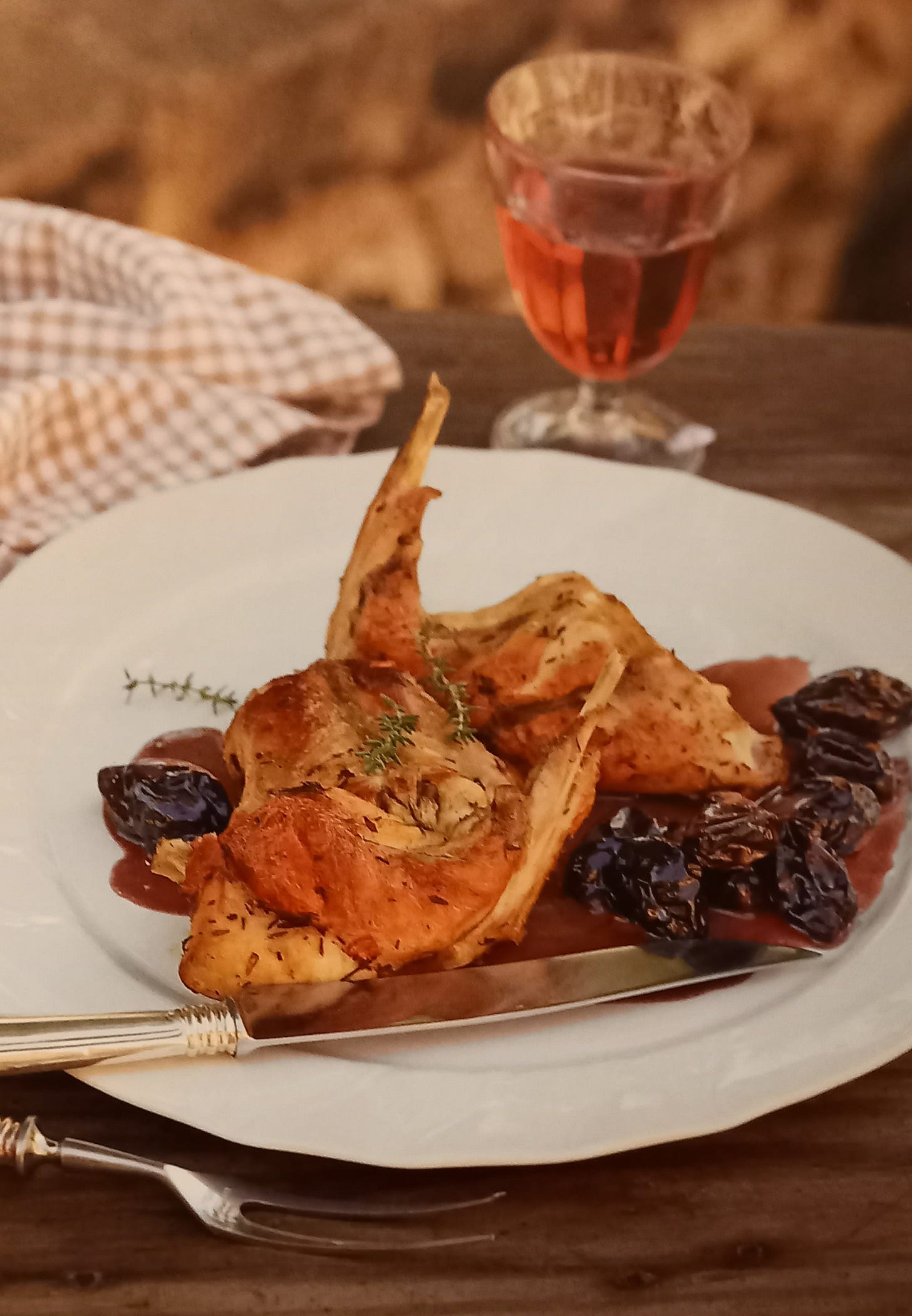One rural winter, a friendly poacher came to the kitchen door, dead rabbit dangling from his hand by its ears. He made a few judicious nicks in its neck then unrolled its skin down its body like a courtesan removing her silken stockings, and offered it to me for the family pot. Only the greatest British phlegm allowed me to receive it without either bursting into tears or gagging.
I'll eat anything. I've eaten fried beetles in Cambodia, guinea pig mole in Mexico (forgive me, children, I was not aware and, yes, it tasted like chicken), cockroach tacos in Oaxaca, boarding house food in England, snake in Indonesia, and ant egg soup in Laos. (You have to spoon it up at speed before the ants swarm out of the bowl.) But rabbit? It's a bit too bedtime-story for my taste.
It's the Beatrix Potter connection, fluffy animals in blue jackets napping amongst soporific lettuces, not to speak of a childhood summer of myxomatosis when the countryside round my aunt's house was heaving with expiring bunnies running in demented circles, their eyes hanging out on their throats.
Conversely, I can get my head round hare with no discomfort. It seems to me that while both animals can give a dog a run for its money, somehow the rabbit is on a losing wicket from the moment it lopes off towards the safety of its burrow. If it isn’t evading baying hounds, it’s under threat from hunters with guns and snares, none of them with the comical incompetence of Disney cartoon characters.
Hares seem made of sterner stuff. Jackrabbits, as they’re known in the US, are canny creatures, zigzagging their scent across the hills, driving pursuing dogs crazy with frustration. They’re good at boxing, too, both sexes pummelling one another with their paws during the frenzied spring battle that gives rise to the expression “Mad as a March hare”. While the males do it to compete for a female, the females lash out to prevent copulation, which may strike a chord. At other times of year, they’re all rather shy creatures.
It’s impressive that a hare ever reaches a cooking pot. The European species can run up to 80 km an hour/50 mph. The five different kinds of jackrabbit from central and western North America can run 65 km per hour/40 mph but over much longer distances. They can also leap up to 3 metres/10 feet high.
The difference between hares and rabbits is that not only are hares larger, with longer ears and black markings, but while rabbits live in colonies in burrows, hares live alone in nests above the ground. There they give birth to fully furred leverets with their eyes open. Baby rabbits, known as kittens, are born underground, blind and hairless.
While my poacher expected me to serve his rabbit stewed and with a mustard sauce, hares are the inspiration for the unctuous Civet de Lievre, a Jugged Hare of Faustian blackness and depth of flavour produced by the addition of its blood. This is why I am not providing you with a recipe for it: I don’t want you to Unsubscribe. Nevertheless, you should try it. It stars at the historic Brasserie La Coupole in Paris where it would be a mistake to distrust any aspect of the menu, especially when the next table is occupied by an exquisitely dressed elderly woman feeding her own Civet de Lievre to the dainty dog with a ribbon securing its fringe balanced on the seat beside hers.
Sensitivity over eating rabbit or hare in the face of this mundane/mondaine behaviour becomes untenable when confronting the prospect of French scorn. I have learned to deal with my squeamishness and now cook rabbit without the need to stiffen my spine.
Farmed rabbit is available year round, as is hare. But make this dish now if you’re going to at all because the best size of wild rabbit (and hare) comes to an end at the beginning of the new year. If you resist the idea of rabbit, chicken can substitute. Now we’re not allowed to visit France, this dish will bring France to you.
For 4
1.5 kg rabbit/3lb3oz, jointed
leaves from a few sprigs of fresh thyme, finely chopped
duck fat or oil
3 large shallots, peeled and finely chopped
2 bay leaves
20 pitted prunes (preferably Pruneaux d'Agen but good quality organic prunes will substitute)
250ml /1 cup/8 fl oz Bergerac red or robust red wine
250ml/1 cup/8 fl oz chicken or veal stock
1 clove garlic, peeled
salt and freshly ground black pepper
Ask the butcher to joint the rabbit. Rub the pieces with the crushed thyme leaves and place in a freezer bag to infuse an hour on the counter or overnight in the fridge. Return to room temperature before cooking. Warm the duck fat in a casserole over medium high heat and brown the pieces. Add the shallots and bay leaves and sauté briefly, then add the prunes, wine and stock. Crush the garlic with the flat of a knife, add to the pan, season with salt and freshly ground black pepper and cover tightly. Braise very gently for 1 ½ hours. Take the lid off then turn the heat up to reduce the liquid to a good strong flavour. With a slotted spoon, place the joints on a warm serving dish. Distribute the prunes around them, then pour the sauce over and serve with potato puree or tagliatelle and anything green languishing in the vegetable drawer.
Find more newsletters with opinions and recipes here. If you want to take issue, please Comment.




Absolutely love your work and recipes. One of the many, friends of Margy. This opening paragraph made me chuckle - alone. I needed that. But, everything is great. So glad I can read you.
I did try jugged hare a few times but as you say the blood, the blood, made it all too heavy. Like ris de veau one left to restaurants who know what they’re doing - unlike me
This is easier rabbit recipe I know
Take farmed rabbit, joint and put in heavy casserole, do layers of rabbit, onion rings, thick bacon, white pepper. Put in very slow low heat oven. 3 hours later, you have a light stew with flesh forked off bone, good hint of salt, onion and pepper fused into thick juice. Brill with mashed potatoes, green beans.
When I worked in Geneva I had a weekend place in Alps. I once organised a dinner high in the mountains to a wonderful 6 table restaurant basically a room in a farmhouse where for FF50-80 la mère de la maison produced 6-8 course meals all fait maison. The highlight for me was her lapin à la moutarde. But my then father-in-law was Vietnamese and almost vomited when it appeared as in Saigon rabbit had same status as rats!
My Irish-Scottish mother would never eat rabbit cos of myxamatosis (sic) and certainly if you see a rabbit dead of it the sight is horrid.